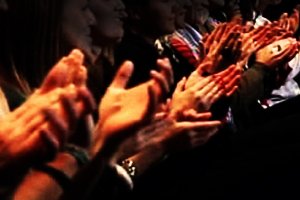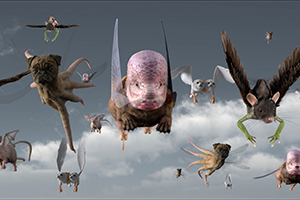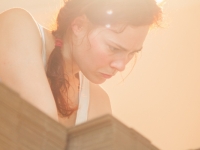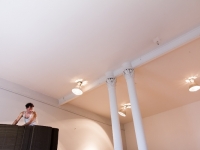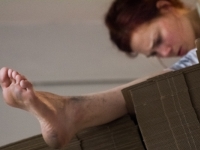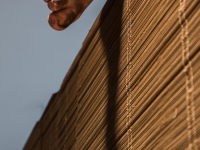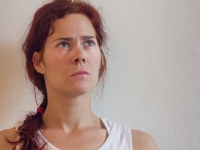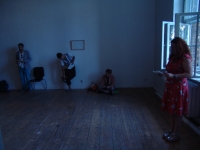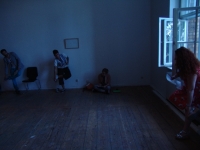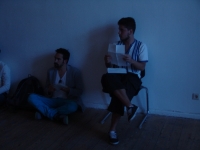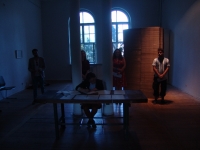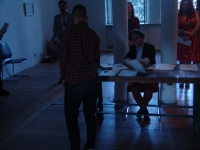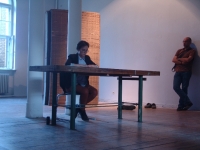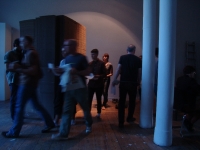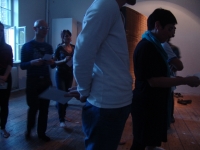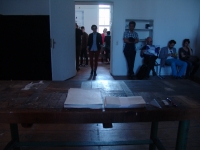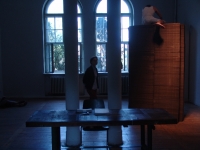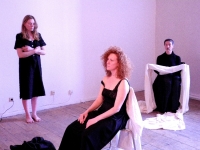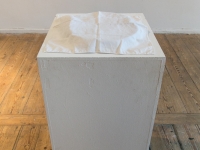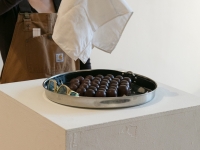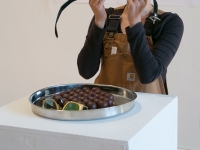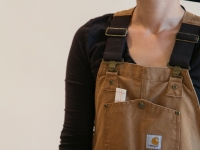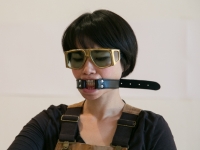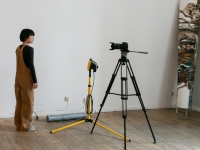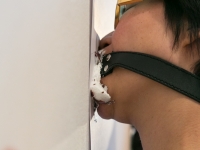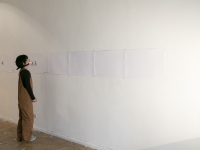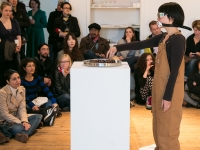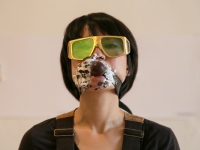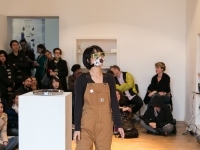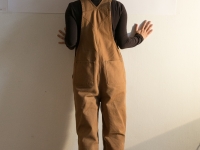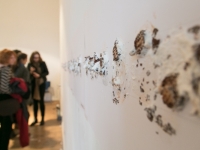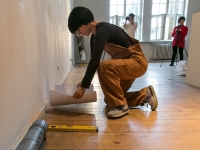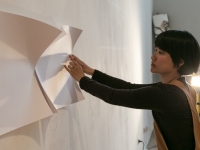WORKS ON PAPER
5 May – 30 June 2013
Sunday Performance Series and Gallery Exhibition in Partnership with Month of Performance Art
ARTISTS:
Joyce Clay, Catherine Duquette, Mariana Hahn, Emi Hariyama and Mariana Moreira,
Kate Hers, Sarah Lüdemann and Adrian Brun, Kirsten Palz, Yulia Startsev
Curated by Rachel Rits-Volloch
Produced by English Cook
5 May
Sarah Lüdemann and Adrian Brun: Blind Spot (13:00 – 17:30)
Yulia Startsev: Ectype ___ (17:45 – 19:00)
12 May
Sarah Lüdemann and Adrian Brun: Blind Spot (13:00 – 17:00)
Catherine Duquette: On Presence | On Paper (17:15 – 18:15)
Emi Hariyama and Mariana Moreira: Impermanence (18:30 – 19:00)
19 May
Kirsten Palz: Manuals for R (17:00 – 17:15)
Joyce Clay: Book I, Book II (17:30 – 18:00)
Mariana Hahn: Empress of Sorrow (18:15 – 19:00)
26 May
Kate Hers: 7 Drawings, 28 Kisses (17:00 – 17:45)
Joyce Clay: Book I, Book II (18:00 – 19:00)
For Month of Performance Art, MOMENTUM curates a month-long program of Performance Sundays entitled WORKS ON PAPER. This exhibition series inverts usual assumptions, inviting performance artists to use paper both as form and as content; not as a blank slate upon which to create, but as a dynamic building block with which to create. Bringing together a diverse group of international artists based in Berlin, MOMENTUM invites them to work on paper and with paper to activate all the possibilities of the medium in unexpected ways. Working through durational performance, instruction pieces, physical and social architecture, live performance in dialogue with video performance, and a diversity of individual practices, WORKS ON PAPER invokes the breadth of performance art to reimagine paper: this most traditional of artistic media.
Following the conclusion of May’s Sunday Performance Series, WORKS ON PAPER transitions into an exhibition showcasing the accumulated artefacts and video records from each artist’s performance. In dialogue with the videography, these object-based remains take on an unexpectedly performative life. As the Performance Series progressed, the artists integrated the artefacts from the previous week’s performances into their own work, effectively reiterating the series itself through the viewpoint of process-based performance. By generating a cumulative, site-specific series through the appropriation of the remains of one another’s performances, the artists in WORKS ON PAPER challenge and reinvigorate the notion of the stationary, disengaged exhibition. What, they ask, is the life of performance after the event concludes?
WORKS ON PAPER will remain on view until 30 June 2013.
 |
WORKS ON PAPER Exhibition Text
“Performance has been considered as a way of bringing to life the many formal and conceptual ideas on which the making of art is based.” RoseLee Goldberg, Performance Art: From Futurism to the Present.
For Month of Performance Art, MOMENTUM presents Works on Paper, a month-long program of Performance Sundays that repurposes and resurrects the most traditional of artistic media: paper. Following in the footsteps of such legendary artists as Josef Albers and Vito Acconci, Works on Paper inverts classic assumptions of the medium, inviting seven performance artists to approach paper not as a static, blank canvas, but rather as a dynamic source of sculptural, conceptual and performative possibility.
As an innovator of early twentieth century performance and art education, Josef Albers famously instructed his beginning students at the Bauhaus to explore the three-dimensional potential of paper. By revealing this fundamental material’s previously latent applications – its performance under tension, cutting, folding and twisting – Albers emphasized the process of materialization and its unexpected deviations over the finished, materialized product. As he explained to his students, “Art is concerned with the HOW and not the WHAT; not with literal content, but with the performance of the factual content. The performance – how it is done – that is the content of art.”
Decades later, American artist Vito Acconci based his performances not on the “page ground” he had formerly used as a poet, but rather on the physical ground of his own body. By shifting focus from the written word to the contours of his own figure, Acconci raised questions about the relationship between artist and object: How do the medium and maker relate, when they become one and the same? And what does it mean to collapse the boundaries between disciplines?
Through grappling with similar questions and themes, the seven international, Berlin-based artists included in MOMENTUM’s Works on Paper diversely approach this fundamental medium. Whether engaging in durational performance, instruction pieces, physical and social architecture, or live performance in tandem with video, these artists challenge expectations of working with traditional materials in real-time. Joyce Clay’s live and video performances consider the body as an extension of performed sculpture, questioning the role of the human figure as a collection of parts versus a singular, materialized whole. Her performances for Works on Paper, Book I and Book II, meld body and paper as an expression of intransient forms and the relation between repurposed, everyday objects. Mariana Hahn’s Empress of Sorrow merges performance, song and poetry and approaches the body as a paper onto which memory – specifically, a woman’s familial memory – is written. Kate Hers’s practice focuses on happenings that engage issues of transnational identity and cultural belonging, often through different modes of communication and public/private interventions. Yulia Startsev will investigate Nikolai Gogol’s book The Overcoat in a workshop-based performance, an event that will examine the self and social relationships in relation to the written – and copied – word. Kirsten Palz’s performance Manuals for R draws from the artist’s ongoing archive of manuals; begun in 2007, this project of over 317 manuals engages topics from dreams to memories to myth and social space. Sarah Lüdemann’s and Adrian Brun’s joint performance uses a mound of cardboard to create an architectural space that engages visitors in various acts of repetition. By continuously sculpting, carving, penetrating and shaping the surface of these mounds, the artists refer to underground movements that undermine political bodies until they collapse. In Impermanence, Emi Hariyama and Mariana Moreira examine the fundamental use of paper as a means of communicating and recording ideas, focusing on the medium’s short and ever-changing lifespan. Finally, Catherine Duquette’s On Presence | On Paper meditates on the notion of presence from the perspective of a writer, probing the gap between the actual and the desired self.
Ultimately, by refracting this traditional medium through the lens of performance, Works on Paper questions and challenges the very nature of artmaking and its formal, conceptual and process-based components.
Text by English Cook
Shot by Dian Zagorchinov, Igor Dimitri and Chiara Nardone; edited by Dian Zagorchinov
Joyce Clay – Book I, Book II
Joyce Clay Bio – Book I Image Gallery – Book II Image Gallery
The underlying theme common to my works is the conflict or dialogue with myself and my interactions with the world. What should I hide about myself? What should I show? What should I reveal? There are questions, there is inquiry – and all of this goes on within the context and with the understanding that I’m sharing the space and creating an experience with other people who are busy with the same thing. The two works I have presented here feature performance, sculpture, and body in an intertwined relationship. Body is a part of the sculpture, and an inseparable piece of it. The performance is putting into question the presence of the body, and the experience is relating to the artist as a person or as a part of the object in that moment. As the designer of these frameworks for experience and an integral performer of them, I experience the performed sculptures as an extension of my body, and as a frame for my body that defines borders, declares division, and offers points of access and inaccessibility. In these works, I create a specific structure for the situation or interaction, which I assume has clear guidelines. However in reality, each person present, individuals loaded with imagination, cultural conditioning, social inhibitions, influence of their peers, will perceive, interpret and act differently in the given situation, and that’s when things get interesting.
Shot and edited by Igor Dimitri
Yulia Startsev – Ectype ___
Yulia Startsev Bio – Image Gallery
“His father’s name was Akaky, so let his son’s name be Akaky too. In this manner he became Akaky Akakiyevich. They christened the child, whereat he wept, and made a grimace, as though he foresaw that he was to be a titular councillor.” (Nikolai Gogol, The Overcoat, p. 1). To write, rather than to speak; to put to paper any given thought is to somehow bind one’s will to language. This is the weight that a paper frequently carries. But, to copy, is to somehow exclude one’s self from the process of making the word real, an avoidance of binding one’s self to the concept and meaning of language. A workshop-based performance will function as research into Nikolai Gogal’s book The Overcoat, both examining the act of copying from the perspective of Akaky Akakiyevich as abstraction, and as a societal relationship.
Shot and edited by Dian Zagorchinov
Sarah Lüdemann and Adrian Brun – Blind Spot
Sarah Lüdemann Bio – Adrian Brun Bio – Image Gallery
The pile of paper containing thousands and thousands of sheets is reminiscent of laborious and repetitive exercises that are used for drill, punishment or mastering a skill. In this sense of an ongoing production and reproduction the pile also generates a metaphor for something one sits on top of in order to breed and keep alive, like a pile of eggs and in a more abstract sense a set of rules and traditions or a system.
In its multitude the sheets of paper become a solid body, which cannot only be marked on the surface, but also carved into, penetrated and shaped both literally and metaphorically. While the structure – the appearance of the pile – remains intact on the outside, changes occur on the inside. Both destroying and building, this penetration of the body may be regarded in a political context as a metaphor for underground movements and the act of undermining systems and ideologies, until they eventually collapse. In the context of scholarly, repetitive exercises the two performers take on the roles of master and disciple.
The seeming authority of the observer or the master is in itself a failure within the system, as the action carried out on top of the pile is not completely visible. Both the observer and the observed are aware of each others presence and their limited control. Somewhat both roles are interchangable, so that everyone is the observer and simultaneously the observed. The acceptance of this ritual is an absurdity in itself, however, it is so that systems continue to function or are eventually changed.
From Germany and Argentina respectively the artists are drawing on their personal histories as well as those of their countries, challenging current political systems and social power structures (class, gender, race, religion) still shaping our times.
Shot by Dian Zagorchinov and Igor Dimitri; edited by Dian Zagorchinov
Mariana Hahn – Empress of Sorrow
Mariana Hahn Bio – Image Gallery
Performers:
Maria Angeli as The Empress of Sorrow
Rowan Hellier as The Deed as Word, Words as Tear
Ingrid Goetlicher as The Lady of History
Mariana Hahn as The Servant of History
The empress is wrapped into Lethe (forgetting)
Lethe is being washed off her.
With each washing, with each further needle work, with each word sung The
Empress remembers more of Ate (sorrow), each sign made upon the hands of
her fellows deepens the inscriptions made by the Lady of History upon her skin,
connects The Empress to the net of the world, until the Empress is fully wrapped
into Ate, into life.
“My dog, an avatar of Job, lacerates my foot with his desperate teeth and forever prints his message of indignation in the flesh of my memory.” This is one of the first sentences of Cixous’s foreword to her Stigmatexts. The body as paper onto which memory is written, wherein an augmentation of memory by a mnesic growth can be perceived; a scar has found its voice, it has been born like a dark star, orbiting the plane of our perception. The stigmatized person shows traits of a saint and an outlaw at the same time, both a martyr and condemned, elected and excluded. This is what the stigma conveys, a paradoxical message: It lives in between the worlds, as an interlocutor of the underlining message of humankind’s ill figure.
Empress of Sorrow is a work that contemplates the body of a being enchained by pattern; the fate of this being’s family writes itself into the body as if it were a blank sheet of paper, with the body of the woman becoming host of the family’s patterned desire to be. The white fabric used in the performance acts as the herald of such a pattern. It tells the story and spins it at the same time.
The cherubs perform an unholy mass, cannibalistic heritage.
There certainly is something sexual about the act of devouring, and of seduction something profoundly animalistic and yet it emits deepest sensuality, the sensuality of the totality within an experienced ecstasy which the empress is silently.
Swollen history, ready to be drunk up.
The performance shows a struggle, a very silent retreaded struggle, a horrendous physical exaltation of trying to rid itself of the inscriptions upon her body, yearning to birth herself, to find an existence outside of linguistic definitions.
And yet she cannot get away from that pattern upon her body. It’s inside.
Shot and edited by Marina Belikova
Kirsten Palz – Manuals for R
Kirsten Palz Bio – Image Gallery
The Manual as Script, Drawing and Experiment. I define the Manual as an open directive and conceptual sketch for a factual or potential intervention in space. The manuals are named after the industrial manual and prescribe the execution, matter and functionality of specific situations and objects. The manuals describe these developments, processes and objects trough texts and diagrams. Manuals for R comprises a selection of manuals written in 2013. These new manuals are a continuation of the series Writings as Sculpture started in 2012.
Shot by Dian Zagorchinov and Chiara Nardone; edited by Dian Zagorchinov
kate hers – 7 Drawings, 28 Kisses
kate hers has been using foreign languages as a medium to explore transnational identity and the construction of self through language for over a decade. Her recent performances investigate problematic German colloquiums while evoking the simplicity of Minimalism, the self-referential tendencies in Conceptualism, and Fluxus art actions. In 7 Drawings, Twenty-eight Kisses, hers makes use of one of her new ready-made objects to create 7 “action drawings” live for the audience. This work was created with the generous support of the Millay Colony for the Arts.
Shot by Dian Zagorchinov and Igor Dimitri; edited by Dian Zagorchinov
Emi Hariyama and Mariana Moreira – Impermanence
Emi Hariyama Bio – Mariana Moreira Bio – Image Gallery
As part of the theme of this work is paper, the stage will be set with multiple levels of hanging paper and a paper cylinder, in which one of the artists will wait prior to the performance. Once the music begins to play, she will dance, playing with light and shadow as it falls upon the paper. Suddenly cutting herself free from the cylinder, the other artist will join in the background, painting the word “Hakanasa” (“transience,” “impermanence,” “fragility of existence”) upon a hanging sheet of paper in Japanese. Both artists, dressed in paper costumes, will be covered with writing and words. As the first artist dances and the second artist works, the paper costumes will be torn from their bodies and the first, through the dance, will tear down the paper hanging with the word “Hakanasa” upon it, revealing another drawing behind. This work, inspired by the main use of paper – communication and recording of ideas – and its short life, focuses on the nature of change as well as the transience of ideas and forms. From the paper cylinder a concept is born in the form of the dancer, described and defined by the words applied to it. From its birth to its eventual destruction, it fights against becoming outdated, oldfashioned and useless. The initial black and white scene evokes the sterility of the written word upon paper, as opposed to the vibrance of reality, and distances the audience from everything except the world of written communication. In its fight against the changing context, the concept’s initial definitions and descriptions are stripped away, leaving it less and less of what it was. Finally, in a last act of violence, the dancer as concept will try to defy the nature of “transience” and “impermanence” itself via her attack on the first canvas, where the second artist will have written “transience”, only to reveal the vibrant piece of art behind: a reality which she cannot destroy, and in acting against it, she is destroyed by it. This work attempts to focus on the utter inability to permanently define or express anything, the inability of the human mind to create an immortal concept.
Shot by Dian Zagorchinov and Igor Dimitri; edited by Dian Zagorchinov
Catherine Duquette – On Presence | On Paper
Catherine Duquette Bio – Image Gallery
What does it mean to be present? How does one close the gap between the actual self and the desired self? On Presence | On Paper is a meditation on the notion of presence, an interactive performance about works on paper from the perspective of the writer. Writing is the act of putting thoughts on paper, of concretizing self, of declaring, “I think, therefore I am – and here’s the proof”. The transference of ideas from mind to page is a simultaneous act of grasping and creating self, whereby the paper becomes body – a vessel containing thoughts that is malleable, desirable, transferable. Witness how one writer navigates the space between perceiving and being, separation and connection. The paper – in all its pliability – serves as her model, a highly coveted blueprint for the writer to become one and the same with her creation. However, the writer’s body appears too rigid to assume paper’s form and the paper’s content too exacting to realize. Propelled by text both off and on paper, the writer observes herself and others, all the while pushing and pulling at feeling present, ultimately unveiling her struggle as a static subject of longing whose creation is more present and powerful than she is.
ON PRESENCE I ON PAPER IMAGE GALLERY:
EMPRESS OF SORROW IMAGE GALLERY:
7 DRAWINGS, TWENTY-EIGHT KISSES IMAGE GALLERY (PHOTOS BY ALEKS SLOTA):


 Back to Homepage
Back to Homepage